How to build a small PC with Mini-ITX
You want to build a new PC yourself, but don't have a lot of space and a little limited budget. So it's time to take a look at the form factor Mini-ITX (the form factor is the term for the size and shape of a particular desktop motherboard). The compact motherboard only measures 170mm x 170mm but can 'revolutionize' the way users use computers.
When build PC users need to have suitable components, carefully collated to ensure compatibility. Today's article will summarize everything readers need to know about building a compact, powerful PC using the Mini-ITX form factor.
Instructions for assembling computers with Mini-ITX
- Uses of a PC using the ITX form factor
- Factors needed to build a mini-ITX PC
- Build PC Mini-ITX in 10 steps
- Step 1: Choose to buy components and check compatibility
- Step 2: Prepare anti-static workspace
- Step 3: Install the CPU
- Step 4: Install heatsink and fan
- Step 5: Install RAM
- Step 6: Prepare the case
- Step 7: Install the motherboard in the case
- Step 8: Add the power supply
- Step 9: Boot test Mini PC
- Step 10: Mount the hard drive
- Install the operating system
Use of an ITX PC
Building a compact Mini-ITX PC is ideal for many uses.
- Use as a compact desktop
- Create media center or PC home theater (HTPC)
- Run as a data server or media server
- Play as a dedicated gaming PC
The steps below are how to build a small, low-power standard desktop. For dedicated HTPC or gaming computer, users can choose to add dedicated graphics card. Similarly, if you want to build a server, you can make the most of your storage options.
Factors needed to build a mini-ITX PC
No matter what size, building a PC has the same basic requirements: Ensure compatible hardware.
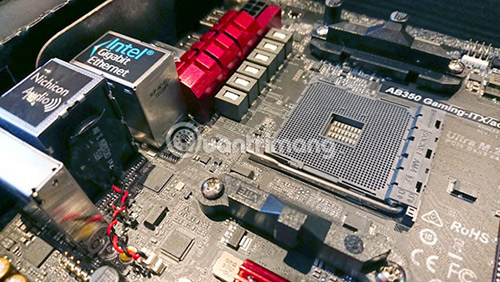
For PC Mini-ITX, you'll need a 170mm x 170mm motherboard, along with a heatsink (heat sink) and fan (low-profile type). If you need a more intensive gaming experience, look for a powerful GPU.
The PC in this tutorial has the following components:
- Case: Cooler Master RC-130-KKN1 Elite 130
- PSU: Corsair VS450
- Motherboard: ASRock AB350 Gaming-ITX / IC
- CPU: AMD Ryzen 3 2200G processor with Radeon Vega 8 Graphics
- RAM: Ballistix Elite 4GB DDR4
- HDD: SanDisk SSD PLUS 120GB Internal SSD
The total cost of building a PC is less than $ 500 (about 11,000,000 VND).
Build PC Mini-ITX in 10 steps
Before proceeding, it is mandatory to read the documentation that came with the motherboard and the case. Understand where the device is connected, which jumper (the connector) and how to configure the BIOS correctly will fix most problems encountered when building a new computer.
Although this is the process of building a small computer, the general principles for building a standard desktop computer still apply. Refer to the article: Self-assemble computers, build desktops of TipsMake.com for more details.
Step 1: Choose to buy components and check compatibility
Once you have decided on the Mini-ITX case, the next step is to choose the hardware that meets the requirements and budget available.
Caution: Users can easily choose the wrong parts. The motherboard modules, CPU and RAM need to be fully compatible, then the computer will work. Therefore, it is recommended to use an online tool to ensure compatibility.
- Crucial.com provides an 'Advisor' tool on RAM compatibility and motherboards.
- Intel.com devotes part of its website to determine hardware compatibility.
- PCPartPicker.com is an excellent independent resource to ensure users will purchase compatible components.
Please check carefully. Order only after determining that it is the required hardware (refer to reviews from other sources).
Step 2: Prepare anti-static workspace
Before taking parts out of the box, take the time to clean up the work area. Then use an antistatic wrist strap.
Next, open the motherboard container, put the anti-static bag aside.
Put the motherboard on the antistatic bag with foam (NOT an antistatic bag) before continuing.
Step 3: Install the CPU
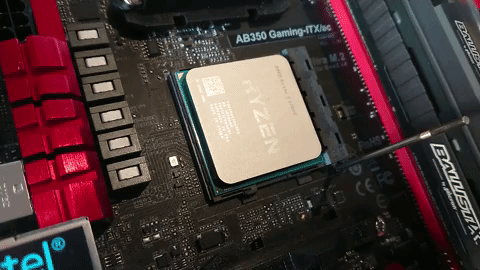
Here's how to install a safety CPU:
1. Open latch on CPU socket. This is the part that helps fix the CPU in place.
2. The CPU will only be set in one direction. The bottom pins all have their own sockets, so it is important that the CPU be placed in the right direction. There is a small triangle in one corner of the CPU; Match a similar icon on the motherboard CPU socket. Make sure the CPU is flat on the socket before proceeding.
3. Lock the CPU in place by closing the newly opened latch above. If the CPU is set correctly, this operation will be done very easily.
This three-step process ensures that the CPU is installed safely and accurately. The process of installing the CPU will vary depending on the socket type.
Step 4: Install heatsink and fan
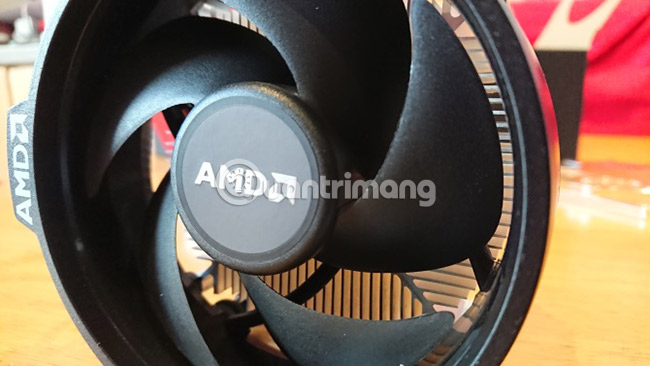
Cooling the CPU is important, so a heatsink and fan are needed to reduce the heat generated when the CPU is operating.
However, another factor can be used: Heat sink. In most cases, heatsinks, fans and heat sinks will always come with the CPU. This means that users do not need to worry about problems arising, such as whether to use the right amount of CPU heat sink or not, etc.
Follow the instructions provided for heatsink mounting and fans on the CPU, then securely fix them.
Step 5: Install RAM
Installing RAM correctly is very important. Without it, the computer cannot run. Incorrect installation can shorten the RAM, as well as the motherboard.
When installing RAM, make sure that the entire module is fully pushed into the slot. In addition, the hooks on both ends of the module will automatically lock if the RAM bar is set correctly.
If you use a lot of RAM, choose the same and the same size to get the best performance.
Step 6: Prepare the case
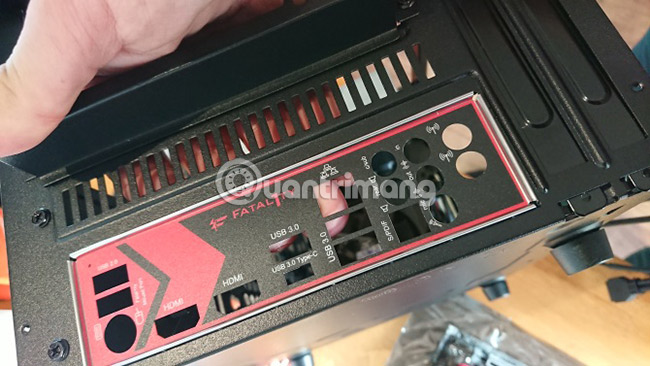
The next step is to be ready to mount the motherboard in the case. Start by twisting the four screws in the case where the motherboard is located.
Once this is done, the input / output (I / O) shield (also called the main shield) of the motherboard will also be in place. This is the metal cover for the ports on the back of the case. It needs to be installed in the correct position before installing the motherboard.
Step 7: Install the motherboard in the case
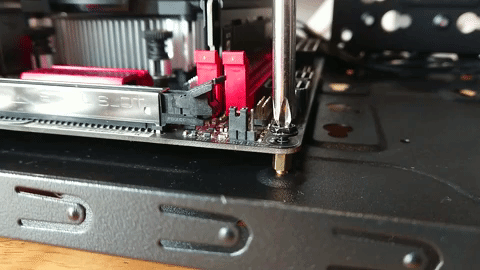
With everything installed on the motherboard, it's time to install it in a compatible Mini-ITX case.
Carefully lift the board, and place it in the case, carefully align it with the screws and I / O shield. The back of the case must be aligned with the ports on the motherboard.
With the motherboard in place, fix it with dedicated screws.
Step 8: Add the power supply
If the case does not have a separate PSU, users will need to install additional PSU. This can cause problems for Mini-ITX cases, which is why it is necessary to choose a compact PSU or case with a standard PSU space.
After installing the PSU, connect the cable to the motherboard according to the instructions in the included instructions. The motherboard receives power from the cable, while the CPU and fan have separate power cables. The remaining PSU cable is for storage devices.
Step 9: Boot test Mini PC
At this stage, checking whether everything works is a good idea. To check your connections, plug in the PC and start it. Remember to turn on the PSU before pressing the button on the front of the case!
When the computer is connected to the screen, you will see the initial POST (power-on-self-test) screen. Part of this is scanning an unconnected storage drive. If you have done this, you will see that the CPU is displayed correctly along with the total amount of RAM.
Hold the power button to turn off the computer and unplug the power plug. Now is the time to install the storage device and install the operating system.
Step 10: Mount the hard drive
Connecting a storage drive (SSD or HDD) to a motherboard is relatively simple. Just connect the SATA data cable from the motherboard to the drive; Then, connect the power cable to the drive. Users also need to protect the drive in an appropriate slot.
However, if the motherboard supports SSD M.2 storage with boot capability, users may prefer to use this. Although this will increase the cost a bit, it delivers much faster data rates and improved performance.
Note: Any Blu-ray drive (or other optical device) intended to be used must be installed at this stage. An optical drive is connected like a storage drive.
Modern cases often have locking mechanisms to keep the drive safe, instead of using screws.
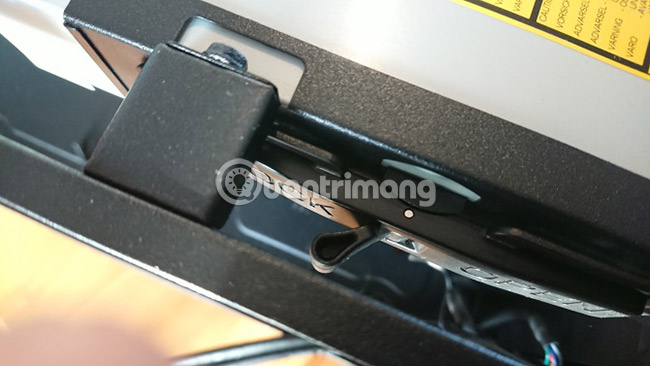
Install the operating system
The selected operating system should be downloaded first and written to USB.
Using Windows, Linux or any other operating system is up to you. However, be aware of hardware compatibility issues.
For example, Windows 7 will not run with Ryzen CPU. In this test build, the author has to choose between installing Windows 10 and Linux (specifically Linux Mint).
This is the kind of compatibility issue you should know before you start.
Building a Mini-ITX PC is not difficult or easier than building a traditional ATX system.
At this point, the new PC must have worked well. If not, check the documentation: Have you set up your motherboard correctly? Is RAM installed correctly? Does your hard drive need to be configured with jumpers installed?
Hope you are succesful.
See more:
- There are 10 million self-build PC's while playing good games
- 8 tips when you want to assemble the computer yourself
- The best online tools to help you assemble and build your computer
You should read it
- Microsoft released Windows 10 build 17074, providing operating systems with many new features
- Self-assembling computers, build desktop computers (P1): Choose hardware
- How to dress Senna DTCL season 2
- How to build beautiful Next.js forms using React Hooks and Material UI
- Microsoft Build 2017 2nd day: Although not a developer, you need to know these contents
- How to build the Nocturne lineup for the DTCL swordsmen season 2
- Tips to use the equipment of the Arena of Truth season 2 most effectively
- Windows 9 helps Microsoft's Build conference 'sell out'
May be interested
- 7 things to know before buying a mini notebook
 simple and cheap. handy and small. mini notebook - a new line of laptop products, designed for students
simple and cheap. handy and small. mini notebook - a new line of laptop products, designed for students - Why Mini PC is all you need?
 modern mini pcs are nothing like the pcs of old, which means it's time to say goodbye to the big, old pcs of the past.
modern mini pcs are nothing like the pcs of old, which means it's time to say goodbye to the big, old pcs of the past. - Why upgrade from Mac mini M1 to Mac mini M4?
 four years later, the m1 mac mini is finally showing its age, and the m4 mac mini's incredible performance makes it a compelling upgrade.
four years later, the m1 mac mini is finally showing its age, and the m4 mac mini's incredible performance makes it a compelling upgrade. - 50+ the most beautiful mini tattoos
 50+ the most beautiful mini tattoos. you can choose any tattoo you want, but in the past few years, small tattoos have always been popular with young people because of their attractive appeal but also bring youthfulness, style and leave a special imprint on muscle
50+ the most beautiful mini tattoos. you can choose any tattoo you want, but in the past few years, small tattoos have always been popular with young people because of their attractive appeal but also bring youthfulness, style and leave a special imprint on muscle - Experience micro phone 2 sim 2 wave, connect to smartphones
 this ultra-small phone has two sim waves, a removable 300 mah battery, and loud speakers.
this ultra-small phone has two sim waves, a removable 300 mah battery, and loud speakers. - 5 most prominent netbooks in 2010
 the toshiba nb305 with excellent keyboard, small mini 210 or the powerful eee pc 1215n are three of the outstanding netbooks launched this year.
the toshiba nb305 with excellent keyboard, small mini 210 or the powerful eee pc 1215n are three of the outstanding netbooks launched this year. - Choosing a small laptop (Laptop mini)
 choosing a small laptop (laptop mini)
choosing a small laptop (laptop mini) - Apple is developing its smallest computer ever
 apple first launched the mac mini computer line in 2005. since then, this small form factor computer has become a staple product in apple's mac ecosystem.
apple first launched the mac mini computer line in 2005. since then, this small form factor computer has become a staple product in apple's mac ecosystem. - Latest Tay Du Mini Code and how to redeem code for rewards
 mini journey to the west offers a diverse role-playing experience with many attractive rewards from giftcodes.
mini journey to the west offers a diverse role-playing experience with many attractive rewards from giftcodes. - How does other mini stand air conditioner fan regulate?
 many people often wonder when it comes to the choice between a mini air conditioner and an air conditioner. so, what are the similarities and differences between these two product lines? follow the article to find the answer!
many people often wonder when it comes to the choice between a mini air conditioner and an air conditioner. so, what are the similarities and differences between these two product lines? follow the article to find the answer!










 What factors affect CPU performance?
What factors affect CPU performance? Does your computer need Intel Core i3, i5 or i7?
Does your computer need Intel Core i3, i5 or i7? How to check the type of graphics card (GPU) on the computer
How to check the type of graphics card (GPU) on the computer Laptop and Desktop, which one do you choose?
Laptop and Desktop, which one do you choose? How to identify hard drive failure, hard drive failure, bad hard drive on Windows
How to identify hard drive failure, hard drive failure, bad hard drive on Windows Dissection of hard drive components
Dissection of hard drive components